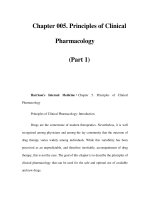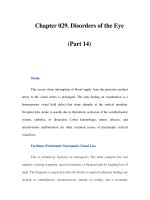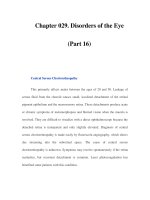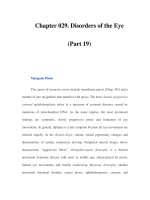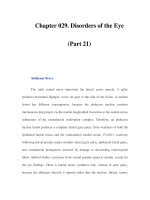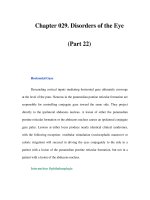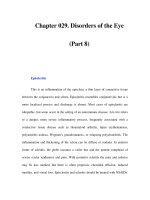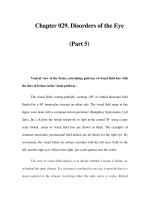Carcinoma of the Esophagus - part 1 pps
Bạn đang xem bản rút gọn của tài liệu. Xem và tải ngay bản đầy đủ của tài liệu tại đây (178.22 KB, 13 trang )
This page intentionally left blank
Carcinoma of the Esophagus
Contemporary Issues in Cancer Imaging
A Multidisciplinary Approach
Series Editors
Rodney H. Reznek
Cancer Imaging, St. Bartholomew’s Hospital, London
Janet E. Husband
Diagnostic Radiology, Royal Marsden Hospital, Surrey
Current titles in the series
Cancer of the Ovary
Lung Cancer
Colorectal Cancer
Carcinoma of the Kidney
Forthcoming titles in the series
Carcinoma of the Bladder
Prostate Cancer
Squamous Cell Cancer of the Neck
Pancreatic Cancer
Interventional Radiological Treatment of Liver Tumours
Carcinoma of the
Esophagus
Edited by
Sheila C. Rankin
Series Editors
Rodney H. Reznek
Janet E. Husband
CAMBRIDGE UNIVERSITY PRESS
Cambridge, New York, Melbourne, Madrid, Cape Town, Singapore, São Paulo
Cambridge University Press
The Edinburgh Building, Cambridge CB2 8RU, UK
First published in print format
ISBN-13 978-0-521-88285-9
ISBN-13 978-0-511-37745-7
© Cambridge University Press 2008
Every effort has been made in preparing this publication to provide accurate and up-to-
date information which is in accord with accepted standards and practice at the time of
publication. Although case histories are drawn from actual cases, every effort has been
made to disguise the identities of the individuals involved. Nevertheless, the authors,
editors, and publishers can make no warranties that the information contained herein is
totally free from error, not least because clinical standards are constantly changing through
research and regulation. The authors, editors, and publishers therefore disclaimall liability
for direct or consequential damages resulting fromthe use of material contained in this
publication. Readers are strongly advised to pay careful attention to information provided
by the manufacturer of any drugs or equipment that they plan to use.
2007
Information on this title: www.cambridge.org/9780521882859
This publication is in copyright. Subject to statutory exception and to the provision of
relevant collective licensing agreements, no reproduction of any part may take place
without the written
p
ermission of Cambrid
g
e University Press.
Cambridge University Press has no responsibility for the persistence or accuracy of urls
for external or third-party internet websites referred to in this publication, and does not
g
uarantee that any content on such websites is, or will remain, accurate or a
pp
ro
p
riate.
Published in the United States of America by Cambridge University Press, New York
www.cambridge.org
eBook (EBL)
hardback
Contents
Contributors vii
Series foreword ix
Preface to Carcinoma of the Esophagus xi
1 Epidemiology and Clinical Presentation in Esophageal
Cancer
Satvinder S. Mudan and Jin-Yong Kang 1
2 Pathology of Esophageal Cancer
Harriet M. R. Deere 14
3 Recent Advances in the Endoscopic Diagnosis of Esophageal
Cancer
Anne Marie Lennon and Ian D. Penman 28
4 Endoscopic Ultrasound in Esophageal Cancer
Anne Marie Lennon and Ian D. Penman 44
5 CT in Esophageal Cancer
Naama R. Bogot and Leslie Eisenbud Quint 62
6 FDG-PET and PET/CT in Esophageal Cancer
Sheila C. Rankin 85
7 The Role of Surgery in the Management of Esophageal Cancer
and Palliation of Inoperable Disease
Robert Mason 107
8 Chemotherapy and Radiotherapy in Esophageal Cancer
Peter Harper and David Landau 122
v
9 Role of Stents in the Management of Esophageal Cancer
Tarun Sabharwal and Andreas Adam 134
10 Lasers in Esophageal Cancer
Laurence B. Lovat 145
Index 151
vi Contents
Satvinder S. Mudan, BSC, MD, FRCS
Consultant in Surgical Oncology
Royal Marsden Hospital
London, UK
Ian D. Penman,
MD, FRCP EDIN
Consultant Gastroenterologist
Lothian University Hospitals Division
Western General Hospital, Edinburgh
Leslie Eisenbud Quint,
MD
Professor of Radiology
Division of Cardiothoracic Imaging
University of Michigan Health System
Ann Arbor, Michigan, USA
Sheila C. Rankin,
FRCR
Consultant Radiologist
Guy’s and St. Thomas’ Foundation Trust
London, UK
Tarun Sabharwal,
FRCR, FRCSI
Consultant Interventional Radiologist and
Honorary Senior Lecturer
Guy’s and St. Thomas’ Foundation Trust
Department of Radiology
St. Thomas’ Hospital
London, UK
viii Contributors
Epidemiology
The epidemiology of esophageal cancer in the Western world has changed drama-
tically over the last two decades. Up until the 1970s most esophageal cancers
were of the squamous cell type, affecting mostly elderly men drawn from the
poorer social classes and influenced by smoking and alcohol consumption. Since
then there has been a dramatic increase in the incidence of adenocarcinoma,
which tends to affect more affluent white men, often in their most productive
years of life [2].
Squamous cell carcinoma
SCC of the esophagus remains in the top ten of cancers globally and represents a
major healthcare problem. The marked geographical variation in incidence sug-
gests that environmental factors are paramount in its causation. High-incidence
Table 1.1 Squamous cell carcinoma and adenocarcinoma of the esophagus:
epidemiology, etiology, and symptoms
Squamous cell carcinoma Adenocarcinoma
Age 60–70 years, median 62.6 years 50–60 years, median 53.4 years
Sex Male dominant, lower socioeconomic
group
Male dominant, middle or upper
socioeconomic group, 52% are
university graduates
Associations Head and neck cancer, smoking, alcohol
excess and liver dysfunction, radiation
exposure, achalasia, poor nutritional
status, human papillomavirus (HPV)
infection, Helicobacter pylori infection,
Plummer–Vinson syndrome, tylosis
palmaris, lye ingestion
Barrett’s esophagus, gastroesophageal
reflux disease, hiatus hernia,
obesity, scleroderma, family history
Location Mostly midesophagus (75% at level
of tracheal bifurcation) and with a
prominently linear growth pattern
and wider nodal spread
Almost always distal one-third of
esophagus (94% entirely subcarinal)
and radial growth pattern with
early local nodal dissemination
Symptoms
and wider
nodal
spread
Progressive dysphagia, odynophagia,
halitosis, unintentional weight loss,
chest pain
Progressive dysphagia, odynophagia,
halitosis, unintentional weight loss,
chest pain
2 S. S. Mudan and J Y. Kang
regions of the world such as Southern and Eastern Africa, and a central Asian belt
passing from Turkey through countries such as Iraq, Iran, and Kazakhstan and on
to Northern China, are marked out by poverty and other poverty-related illnesses.
The incidence in high-risk provinces can reach up to 100/10 000 per year compared
to 5–10/10 000 per year in Western countries [2]. In the USA, SCC is more
common among black people than among white people, but incidence rates have
fallen by half across both groups between 1970 and 2000, with incidence rates of
approximately 2/100 000 for white males and 10/100 000 for black people in 2000
[1,2,5]. These figures are probably related to increasing levels of wealth and
education and reduction in exposure to causative agents.
The male : female ratio is 3:1 except in high-incidence areas where the distribu-
tion is more equal and reflects an equal exposure to risk factors [6]. Regional,
socioeconomic, and racial variation within a country is demonstrated by a higher
incidence of SCC in low income and low socioeconomic groups [5,7,8].
Adenocarcinoma
The last 30 years have seen a dramatic fall in the incidence of noncardia gastric
cancer and, as mentioned earlier, a decline or stabilization in the incidence of SCC
of the esophagus in Western countries [9,10,11,12,13]. Over the same period the
age-standardized incidence of adenocarcinoma of the lower esophagus, previously
a rare disease with incidence <1/100 000, has risen more rapidly than any other
malignancy in the Western world. Since the mid 1990s its incidence has exceeded
that for SCC [14,15,16]. The rise in incidence is most marked in the white male
population, reaching about 5/100 000 for the white males in North America and
8–12/100 000 for white males in the highest incidence countries of Australia and
the UK [7,13,17,18,19,20,21,22]. This represents an increase of about 400–800%
from the 1970s and is about four times greater than the incidence for black males
in the United States. The trend is similar for other North European countries
[10,23,24,25]. Not only is the incidence higher in white males, but the annual
increase in incidence, $10% per year, is higher than for other racial groups and for
white females, leading to an increasing sex and racial ratio [17,26,27]. The demo-
graphic distribution shows an age peak at 50–60 years and a male : female ratio
between 2:1 and 12:1 [23]. Although it is possible that improved anatomic classi-
fication and histological verification might account for some of the time trends
noted, the rapid changes point to a newly acquired etiological risk factor
[10,13,14].
Epidemiology and Clinical Presentation in Esophageal Cancer 3
